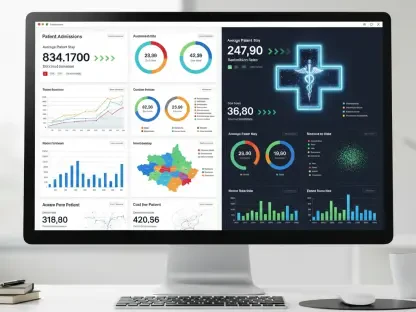Introduction to the Escalating Crisis in Healthcare Data Security
In 2024, the healthcare sector faced an unprecedented crisis as data breaches soared to staggering heights, with a record-breaking 276 million patient records compromised in a single year, underscoring a growing threat to patient privacy. This alarming statistic raises urgent concerns about the security of sensitive health information in an increasingly digital world. The scale of these breaches not only shatters previous records but also exposes deep vulnerabilities within healthcare systems, leaving millions at risk of identity theft and fraud.
The sophistication of cyberattacks has evolved dramatically, with hackers exploiting gaps in digital infrastructure at an alarming rate. Healthcare organizations, often burdened by outdated systems and limited resources, struggle to keep pace with these advanced threats. This situation is compounded by systemic challenges, such as inadequate funding for regulatory oversight and inconsistent security practices across the industry.
Critical questions emerge from this crisis: What factors are driving breaches to such historic levels? How do systemic issues, from underfunded enforcement to supply chain weaknesses, contribute to this epidemic of data exposure? Exploring these concerns is essential to understanding the full scope of the problem and identifying pathways to protect patient data.
Background and Importance of Healthcare Data Breach Trends
Since the tracking of significant healthcare data breaches began over a decade ago, the frequency and severity of these incidents have escalated sharply, as documented by federal authorities. By 2023, the number of reported breaches had climbed to 725, affecting over 133 million records, a trend that only intensified into 2024 with the exposure of 276 million records. This historical rise reflects not just an increase in attacks but also the growing scale of damage inflicted by each incident, often impacting millions in a single event.
The significance of this issue lies in the unique value of healthcare data on the black market, where it fetches a higher price than financial information due to its long-term usability for fraudulent activities. Unlike credit card data, which can be quickly canceled, health records provide enduring opportunities for exploitation, making the sector a prime target for cybercriminals. This reality amplifies the stakes for both organizations and patients, as breaches extend far beyond immediate financial loss.
Beyond individual harm, the societal impact is profound, eroding trust in healthcare providers and imposing heavy financial burdens on affected entities through fines and recovery costs. Regulatory pressure under frameworks like HIPAA continues to mount, pushing for stronger data protection measures. However, the persistent rise in breaches suggests that current efforts fall short, highlighting the urgent need for a broader examination of security practices and enforcement mechanisms.
Research Methodology, Findings, and Implications
Methodology
To assess the state of healthcare data breaches, comprehensive data collection has been conducted, focusing on incidents affecting 500 or more records, as required for public reporting under HIPAA since tracking began. This structured approach ensures a consistent baseline for analyzing large-scale breaches across the sector. The dataset includes detailed records of breach occurrences, affected individuals, and contributing factors, forming a robust foundation for trend analysis.
Primary sources for this research encompass federal breach reports and analyses updated through October 20, 2024, capturing the most recent and relevant statistics. Additional insights are drawn from case studies, such as the monumental Change Healthcare breach, alongside statistical evaluations of breach causes and the entities involved. These diverse inputs provide a multifaceted view of the evolving threat landscape.
The methodology also incorporates regulatory enforcement data, examining actions and investigation backlogs to gauge the effectiveness of oversight. By blending quantitative trends with qualitative examples, a clearer picture emerges of how breaches unfold over time and what systemic patterns drive their persistence. This rigorous process aims to inform both policy and practical responses to the crisis.
Findings
Analysis reveals that 2024 marked a historic peak with 276 million records breached, largely due to the Change Healthcare incident, which alone compromised 190 million individuals’ data. This event stands as the largest breach ever recorded, illustrating the catastrophic potential of targeted cyberattacks on major healthcare entities. The sheer volume of exposed records in a single year surpasses all previous benchmarks, signaling an urgent escalation.
Cyber threats dominate the current landscape, with hacking constituting nearly 80% of breaches in 2023, a sharp increase from earlier years when physical loss or theft was more common. Business associates, entities providing services to healthcare organizations, played a significant role in data exposure, with over 93 million records compromised through their systems in 2023, compared to far fewer at direct providers. This highlights a critical vulnerability in the supply chain.
Regulatory responses have intensified, yet challenges remain, as evidenced by a persistent backlog of investigations due to limited funding for oversight bodies. Enforcement actions, while frequent, often target smaller violations, with larger penalties becoming less common since their peak several years ago. These findings point to a complex interplay of rising threats and constrained resources in addressing the breach epidemic.
Implications
Practically, these findings underscore an immediate need for healthcare organizations to adopt advanced cybersecurity measures, such as encryption and two-factor authentication, to safeguard sensitive data. Strengthening digital defenses is no longer optional but a critical priority to mitigate the risk of large-scale exposures that can devastate both finances and reputation. Organizations must act swiftly to close existing gaps.
On a societal level, the massive data exposures fuel risks of identity theft and diminish public confidence in healthcare providers, as patients grapple with the fallout of compromised personal information. The scale of breaches like the one at Change Healthcare reveals how a single incident can affect millions, creating widespread uncertainty. This erosion of trust poses a long-term challenge to the sector’s credibility.
Theoretically, the surge in breaches calls for a reevaluation of regulatory frameworks to address systemic enforcement gaps, including the need for increased funding to clear investigation backlogs. Developing updated policies that keep pace with cybercriminal tactics is essential to create a more resilient system. Such reforms could redefine how data protection is approached, ensuring both deterrence and accountability in an evolving threat environment.
Reflection and Future Directions
Reflection
Addressing healthcare data breaches presents formidable challenges, particularly as cyber threats evolve faster than many security measures can adapt. The rapid shift to digital platforms, while beneficial for efficiency, has exposed new vulnerabilities that current defenses often fail to counter effectively. This dynamic creates a relentless cycle of risk that demands constant innovation in protective strategies.
Limitations in existing data further complicate the issue, with potential underreporting of breaches at business associates skewing the true scope of the problem. Additionally, backlogs in regulatory investigations hinder timely responses, leaving some incidents unaddressed for extended periods. These gaps suggest that the full extent of the crisis may not yet be fully understood, necessitating more robust reporting mechanisms.
Expanding research scope to include smaller breaches, those affecting fewer than 500 records, could offer a more complete perspective on data security challenges. While current tracking focuses on larger incidents, capturing the impact of minor exposures might reveal additional patterns or vulnerabilities. Such an approach would enhance the depth of understanding and inform more comprehensive solutions.
Future Directions
Future research should explore the potential of predictive analytics to identify system weaknesses before breaches occur, shifting the focus from reaction to prevention. By leveraging data patterns, healthcare entities could anticipate threats and fortify defenses proactively. This emerging field holds promise for transforming how risks are managed in a digital age.
Another critical area for investigation is the implementation of mandatory cybersecurity certifications for business associates to bolster supply chain security. Establishing standardized requirements could ensure that third-party vendors meet stringent protective criteria, reducing the likelihood of breaches through external partners. This measure would address a significant weak link in the current ecosystem.
Legislative and funding support must also be prioritized to enhance regulatory capacity and update penalty structures for greater deterrence. Increasing resources for oversight bodies would enable faster investigation resolutions, while modernized fines could better reflect the severity of violations. These steps are vital to building a stronger framework for data protection in healthcare.
Conclusion: Addressing the Unprecedented Threat of Data Breaches
The alarming surge in healthcare data breaches during 2024, with 276 million records compromised, established a grim milestone that demanded immediate attention. Key findings pointed to the overwhelming dominance of cyber threats, critical vulnerabilities through business associates, and persistent regulatory challenges as core drivers of this crisis. These insights painted a stark picture of a sector under siege by evolving risks.
Looking ahead, actionable steps emerged as essential to combat this threat, including widespread adoption of advanced security technologies and stricter oversight of third-party vendors to prevent future exposures. Policymakers and industry leaders needed to collaborate on increasing funding for regulatory bodies, ensuring that enforcement kept pace with the scale of violations. Additionally, exploring innovative tools like predictive analytics offered a pathway to anticipate and neutralize risks before they materialized, providing a forward-thinking approach to safeguard patient data and rebuild trust in healthcare systems.









